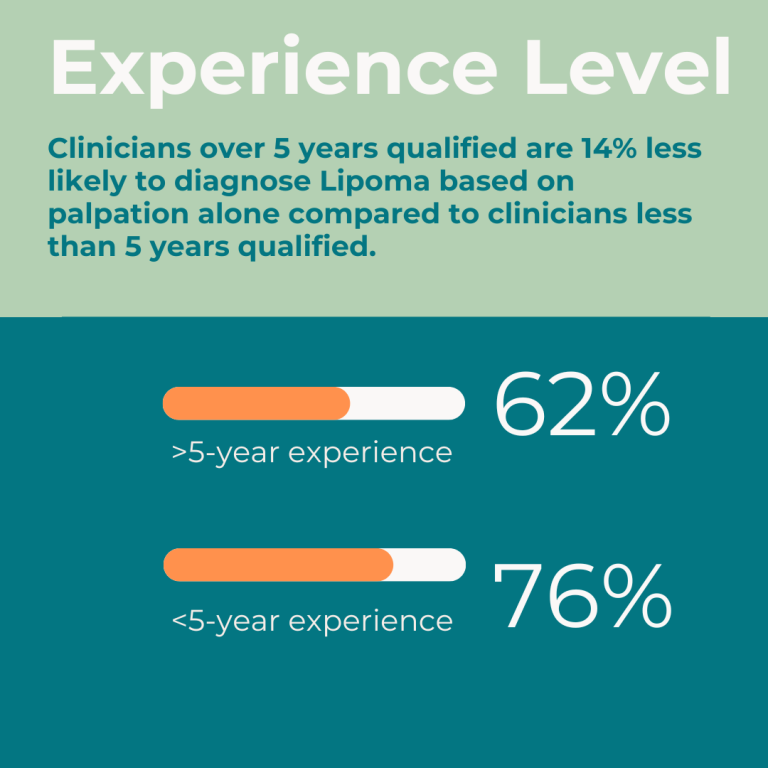
Experienced Vets Are 14% Less Likely To Diagnose Lipoma Based Purely On Palpation, Survey Shows.
A recent survey on dermal and subcutaneous masses in dogs* has shown that 65% of clinicians are diagnosing lipoma based solely on palpation. The survey showed that more experienced vets recognise the limitations of this as clinicians with more than 5 years’ experience are 14% less likely to diagnose a lipoma based on palpation alone compared to clinicians with less than 5 years’ experience. Furthermore only 37% of clinicians use FNA and cytology when investigating a suspected lipoma. Lipomas are very common in dogs and pose little threat to their wellbeing. Other tumours can often present similarly and differentiation between them is essential. There is an increased chance of misdiagnosis in cases that have not had an adequate mass assessment, and HT Vista urge practising vets to utilise an accurate screening process for early detection of malignant masses.
Dr. Gillian Dank, Board Certified Oncologist and Chief Veterinary Officer at HTVet, comments, “There is no way to know that a mass is a lipoma based on palpation alone. The fact that a mass is subcutaneous, soft and circumscribed is not exclusive to lipoma and it could be a number of things including a mast cell tumour or sarcoma. On average a veterinary practice sees over 500 dermal and subcutaneous masses each year. We know anecdotally, and surveys like this confirm, that not every mass is aspirated – and that is why there is need for the HT Vista screening device. Every mass that comes in should be properly examined.”
“It’s interesting to see that the more experienced a clinician is, the less confident they are in diagnosing from palpation and this shows us that with experience we understand that our hands are not enough.”
Furthermore, the company reports a number of recently obtained scans which have shown a mast cell tumour growing beneath a lipoma. This further highlights how palpation alone is not an accurate source of diagnosing a mass. One such case occurred in a 13-year-old cocker spaniel with a history of lipomas. A new mass looked and felt similar to previous lipomas, and had an inconclusive FNA. A HT Vista scan recommended further investigation, and on histopathology the mass was confirmed to be a low grade mast cell tumour.
The survey, carried out by HT Vista, has also shed light on the reasons a clinician believes their clients would decline further investigation of a mass. Half of those surveyed cited cost as a barrier to further investigation. The most common reasons vets would not perform an FNA were due to a short consult time (23%) and confidence in results (20%).
Encouragingly 63% of vets base their decision to introduce a new product into the clinic based on evidence based veterinary medicine and/or and expert or key opinion leader (KOL) recommendation.
Liron Levy-Hirsch, Managing Director of HT Vista, reflects on the current use of cytology, “The survey showed that vets are conscious of the cost to clients, and also feel pressured due to time. We have developed the HT Vista to complement FNA and cytology, and hope clinicians find it a useful tool. Firstly, it is quick and affordable to scan, and for those masses that are benign it removes the need for unnecessary FNA’s. Secondly, vets are often wary of cost, however if a mass is scanned and the results indicate that further investigation is needed, there is more rationale to spend the extra money to get the cytology results. Finally, the device can offer complete confidence that malignancies are not being missed, and if a mass is malignant a prompt treatment plan can be initiated.”
The HT Vista device is a non-invasive, quick screening tool that can accurately determine if a mass is benign or requires further investigation, delivering results within minutes. It utilises Heat Diffusion Imaging technology and an AI based algorithm which has been trained on thousands of scans and is constantly improving.
The full results of the survey can be found here: https://www.vetreport.net/wp-content/uploads/2023/08/Lump-and-Bump-Survey-2023FINAL.pdf . Gillian Dank has an in-depth discussion with The Webinar Vet on confidence in diagnosing masses and can be listened to here. For more information on the HT Vista device or to book a demo, visit https://ht-vista.uk/
*Survey: Dermal and subcutaneous masses in dogs survey. Conducted by HT Vista Ltd using an online questioner offering participants multiple answer questions. The survey was conducted between May 2023 and July 2023. Results have been analysed using Microsoft Excel formulation, and concluded in July 2023.
More from Companion Consultancy
- CoVet partners with Merlin to boost client communication and reduce admin workload
- Dignipets releases new pet Quality of Life monitoring app in time for London Vet Show
- Dr Kelly Foden to offer end-of-life care in Taunton and South Somerset with Dignipets
- KRKA UK honours excellence in its Veterinary Reception Awards 2025
- KRKA UK and Professor Stuart Carmichael lead LVS session on rethinking canine osteoarthritis

 2 years ago
2 years ago  1329 views
1329 views
 4 days ago
4 days ago 